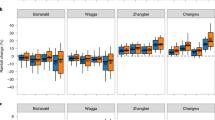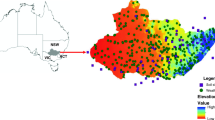Abstract
The use of different downscaling methods (DSMs) to generate downscaled daily climate (DDC) data for assessing climate change impacts on wheat cropping systems was investigated. DDC data were generated from SRES A2 emission scenario simulations of seven global climate models (GCMs) using two different change factor methods, denoted as DTS and RSC, and two weather generator methods, LARS-WG (LWG) and NWAI-WG (NWG). The DDC data were used to drive the Agricultural Production Systems sIMulator (APSIM) wheat model. Significant differences in future changes in simulated crop growth and soil water balance were found between the four DSMs. For raw GCM output, multi-GCM mean changes by the mid-twenty-first century in annual mean temperature (AMT) ranged from +1.2 to +2.0 °C and in annual rainfall (AR) ranged from −11 to −5% across the 6 study sites. The DTS, LWG and NWG SDMs modified the raw GCM changes in both AMT and AR. As a result, climate change impacts on crop growth and soil water balance are not well correlated between DSMs. Since different DSMs give different impact results, we conclude that in addition to using multiple GCMs, selecting appropriate DSMs can be an important consideration in climate change impact assessments.


Similar content being viewed by others
References
Anwar MR, Liu DL, Macadam I, Kelly G (2013) Adapting agriculture to climate change: a review. Theor Appl Climatol 113:225–245
Asseng S, Ewert F, Rosenzweig C, Jones J, Hatfield J, Ruane A, Boote K, Thorburn P, Rötter R, Cammarano D (2013) Uncertainty in simulating wheat yields under climate change. Nat Clim Chang 3:827–832
Cammarano D, Stefanova L, Ortiz BV, Ramirez-Rodrigues M, Asseng S, Misra V, Wilkerson G, Basso B, Jones JW, Boote KJ (2013) Evaluating the fidelity of downscaled climate data on simulated wheat and maize production in the southeastern US. Reg Environ Chang 13:101–110
Challinor A, Watson J, Lobell D, Howden S, Smith D, Chhetri N (2014) A meta-analysis of crop yield under climate change and adaptation. Nat Clim Chang 4:287–291
Déqué M, Rowell D, Lüthi D, Giorgi F, Christensen J, Rockel B, Jacob D, Kjellström E, De Castro M, van den Hurk B (2007) An intercomparison of regional climate simulations for Europe: assessing uncertainties in model projections. Clim Chang 81:53–70
Diaz-Nieto J, Wilby RL (2005) A comparison of statistical downscaling and climate change factor methods: impacts on low flows in the River Thames, United Kingdom. Clim Chang 69:245–268
Dietzel R, Liebman M, Ewing R, Helmers M, Horton R, Jarchow M, Archontoulis S (2015) How efficiently do corn-and soybean-based cropping systems use water? A systems modeling analysis. Glob chang biol
Elliot W, Arnold C (2001) Validation of the weather generator CLIGEN with precipitation data from Uganda. Trans ASAE 44:53
Fowler H, Blenkinsop S, Tebaldi C (2007) Linking climate change modelling to impacts studies: recent advances in downscaling techniques for hydrological modelling. Int J Climatol 27:1547–1578
Haerter J, Hagemann S, Moseley C, Piani C (2011) Climate model bias correction and the role of timescales. Hydrol Earth Syst Sci 15:1065–1079
Hansen J, Sato M, Ruedy R, Lo K, Lea DW, Medina-Elizade M (2006) Global temperature change. Proc Natl Acad Sci 103:14288–14293
Hayhoe HN (2000) Improvements of stochastic weather data generators for diverse climates. Clim Res 14:75–87
Jeffrey SJ, Carter JO, Moodie KB, Beswick AR (2001) Using spatial interpolation to construct a comprehensive archive of Australian climate data. Environ Model Softw 16:309–330
Liu DL, Zuo H (2012) Statistical downscaling of daily climate variables for climate change impact assessment over New South Wales, Australia. Clim Chang 115:629–666
Lobell DB, Burke MB (2010) On the use of statistical models to predict crop yield responses to climate change. Agric For Meteorol 150:1443–1452
Ludwig F, Asseng S (2010) Potential benefits of early vigor and changes in phenology in wheat to adapt to warmer and drier climates. Agric Syst 103:127–136
Macadam I, Pitman AJ, Whetton PH, Liu DL, Evans JP (2014) The use of uncorrected regional climate model output to force impact models: a case study for wheat simulations. Clim Res 61:215–229
Meehl GA, Covey C, Delworth T, Latif M, McAvaney B, Mitchell JFB, Stouffer FJ, Taylor KE (2003) The WCRP CMIP3 multi-model dataset: a new era in climate change research. Bull Am Meteorol Soc 88:1383–1394
O’Leary GJ, Liu DL, Ma Y, Li FY, McCaskill M, Conyers M, Dalal R, Reeves S, Page K, Dang YP, Robertson F (2016) Modelling soil organic carbon 1. Performance of APSIM crop and pasture modules against long-term experimental data. Geoderma 264:227–237
Potgieter A, Meinke H, Doherty A, Sadras V, Hammer G, Crimp S, Rodriguez D (2013) Spatial impact of projected changes in rainfall and temperature on wheat yields in Australia. Clim Chang 117:163–179
Qian B, Gameda S, Hayhoe H, De Jong R, Bootsma A (2004) Comparison of LARS-WG and AAFC-WG stochastic weather generators for diverse Canadian climates. Clim Res 26:175–191
Qian B, Hayhoe H, Gameda S (2005) Evaluation of the stochastic weather generators LARS-WG and AAFC-WG for climate change impact studies. Clim Res 29:3–21
Racsko P, Szeidl L, Semenov M (1991) A serial approach to local stochastic weather models. Ecol Model 57:27–41
Richardson CW (1981) Stochastic simulation of daily precipitation, temperature, and solar radiation. Water Resour Res 17:182–190
Richardson CW, Wright DA (1984) WGEN: a model for generating daily weather variables. ARS (USA)
Semenov MA, Brooks RJ, Barrow EM, Richardson CW (1998) Comparison of the WGEN and LARS-WG stochastic weather generators for diverse climates. Clim Res 10:95–107
Semenov MA, Barrow EM, Lars-Wg A (2002) A stochastic weather generator for use in climate impact studies. User Manual, Hertfordshire
Sharpley A, Williams J (1990) Erosion productivity impact calculator: 1. Model documentation (EPIC). US Department of Agriculture 1990235
Suppiah R, Hennessy KJ, Whetton PH (2001) Projected changes in temperature and heating degree-days for Melbourne, 2003–2007. Citeseer
Wang B, Liu DL, Asseng S, Macadam I, Yu Q (2015) Impact of climate change on wheat flowering time in eastern Australia. Agric For Meteorol 209:11–21
Wilby RL, Wigley T (1997) Downscaling general circulation model output: a review of methods and limitations. Prog Phys Geogr 21:530–548
Wilby RL, Wigley T, Conway D, Jones P, Hewitson B, Main J, Wilks D (1998) Statistical downscaling of general circulation model output: a comparison of methods. Water Resour Res 34:2995–3008
Yang Y, Liu DL, Anwar MR, Zuo H, Yang Y (2014) Impact of future climate change on wheat production in relation to plant-available water capacity in a semiaridenvironment. Theor Appl Climatol 115:391–410
Yang Y, Liu DL, Anwar MR, O’Leary G, Macadam I, Yang Y (2016) Water use efficiency and crop water balance of rainfed wheat in a semi-arid environment: sensitivity of future changes to projected climate changes and soil type. Theor Appl Climatol 123:565–579
Zhang X-C (2005) Spatial downscaling of global climate model output for site-specific assessment of crop production and soil erosion. Agric For Meteorol 135:215–229
Acknowledgements
We acknowledge the modelling groups, the Program for Climate Model Diagnosis and Intercomparison (PCMDI) and the WCRP’s Working Group on Coupled Modelling (WGCM) for their roles in making available the WCRP CMIP3 multi-model dataset. Support of this dataset is provided by the Office of Science, US Department of Energy.
Author information
Authors and Affiliations
Corresponding author
Electronic supplementary material
ESM 1
(PDF 2874 kb).
Rights and permissions
About this article
Cite this article
Liu, D.L., O’Leary, G.J., Christy, B. et al. Effects of different climate downscaling methods on the assessment of climate change impacts on wheat cropping systems. Climatic Change 144, 687–701 (2017). https://doi.org/10.1007/s10584-017-2054-5
Received:
Accepted:
Published:
Issue Date:
DOI: https://doi.org/10.1007/s10584-017-2054-5




